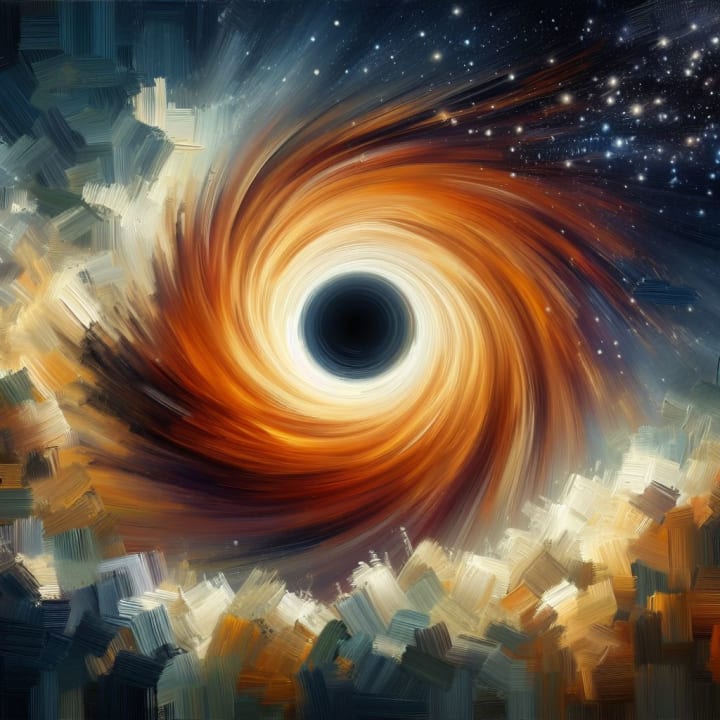CAN a black HOLE become a STAR?
Can these mysterious voids ever turn back into a star?

- No Cosmic Comeback: Black holes, born from collapsing stars, can’t reverse the process. Entropy and the one-way gravitational street ensure a black hole stays a black hole—no stellar rebirth.
- Entropy Rules: The ordered world of stars clashes with the chaos inside black holes. Entropy’s law forbids tidying up the mess, sealing the fate of a collapsed star.
- Black Holes Unveil Cosmic Secrets: Though they can’t transform, black holes are cosmic goldmines. They reveal the universe’s evolution, producing dazzling phenomena like quasars and gravitational waves, challenging our understanding of space, time, and matter.
Hey there! Let’s dive into the wild world of black holes together. Imagine a black hole as the cosmic vacuum cleaner – it sucks everything in, even light! Now, some might wonder, can these mysterious voids ever turn back into a star? Let’s chat about why, according to the cosmic rulebook, it’s a firm “no.”
So, you know how a black hole forms, right? It’s like a massive star throwing a dramatic tantrum – running out of fuel, collapsing under its own weight, and bam! Black hole born. At its heart lies a singularity, a point where density goes bonkers, and nothing, absolutely nothing, can escape its gravitational grip. This boundary is the event horizon, the point of no return for anything foolish enough to venture too close.

Now, the big question: Can a black hole have a cosmic makeover and become a star again? Well, enter the buzzkill – entropy. It’s like the cosmic chaos-meter, measuring how messy things are. Stars are all neat and orderly, atoms playing nice through nuclear fusion. Black holes, on the other hand, are the ultimate hoarders, cramming everything into a singularity. According to the second law of thermodynamics, chaos can only increase or chill; it never tidies up. So, sorry, no process can magically un-mess a black hole into a star.
The gravitational field of a black hole is like a neighborhood with an overbearing landlord. Anything nearby – light, gas, dust, or even other stars – gets sucked in, never to be seen again. It’s a one-way street, and there’s no cosmic U-turn. Even exchanging cosmic gossip is off the table, except for the Hawking process, a quantum trick where a black hole emits radiation and loses mass. But it’s the slowest magic show in the universe, taking eons for a black hole to vanish. And even if it did, it wouldn’t be a radiant star reborn – just a burst of particles and radiation.
So, in the grand play of physics and astronomy, a black hole is the final act. Once a star becomes a black hole, that’s it – game over.

But hold up, that doesn’t mean black holes are just interstellar party poopers. They’re cosmic goldmines, holding the secrets of our universe’s evolution. They’re the leftovers of the mightiest stars, responsible for dazzling spectacles like quasars, jets, and the mystical gravitational waves. Black holes are also like the rebel students in the physics class, pushing the limits of what we know about space, time, matter, and even information.
In a nutshell, while a black hole can’t pull off a stellar comeback, it’s not a galactic dead end. Far from it! They’re our cosmic teachers, guiding us through the weird and wonderful realms of the universe. So, here’s to black holes – the enigmatic remnants of stars, the gatekeepers of cosmic secrets, and the ultimate puzzles challenging our understanding of the cosmos.
Hope you enjoyed this cosmic chat! Got any thoughts or questions? Drop a comment below. Your universe-loving friend signing off – until our next cosmic rendezvous. Stay curious, and have an interstellar day! 😊
More queries
What is the difference between a stellar-mass black hole and a supermassive black hole?
There are two types – stellar-mass and supermassive. Stellar-mass black holes are born when a big star dies and collapses. They can be a few times or hundreds of times heavier than our Sun. Supermassive black holes are the big bosses, sitting at the center of galaxies. They can be millions or billions of times heavier than our Sun. We’re not sure how they form, but they might come from the collapse of huge gas clouds or from smaller black holes merging together.
How does Hawking radiation affect the evaporation of black holes?
This is like a black hole’s slow leak. It’s a type of radiation that black holes give off. It’s named after the physicist Stephen Hawking who came up with the idea. This radiation is super faint and hard to detect. But it’s important because it slowly reduces a black hole’s mass and energy, causing it to shrink and eventually disappear. This happens really slowly for big black holes, but faster for smaller ones.
What are the conditions for a star to collapse into a black hole?
A star can collapse into a black hole if it’s heavy enough – more than about three times the mass of our Sun. When a star runs out of fuel, it can’t hold itself up against its own gravity and starts to collapse. If it’s heavy enough, it’ll turn into a black hole, which is a place where gravity is so strong that nothing can escape, not even light.
How can we detect the gravitational waves produced by black hole mergers?
These are ripples in space that happen when two black holes merge. We can detect these waves with special equipment like LIGO. LIGO uses lasers to look for tiny changes in space caused by these waves. This gives us direct evidence that black holes exist and can tell us a lot about them.
What are some of the unsolved mysteries about black holes and their singularities?
There are a few big questions we’re still trying to answer. One is about the singularity, the point inside a black hole where everything becomes infinitely dense and space and time stop existing. Another is about how supermassive black holes form and grow, and how they affect galaxies. And a third is about what happens to information that falls into a black hole. According to one theory, it should be lost forever, but according to another, it should be preserved. This is a big paradox that we’re still trying to solve.
About the Creator
Yusuf Alam
Crafting Words into Amazing Stories | Freelance Copywriter | Turning Ideas into Impact






Comments
There are no comments for this story
Be the first to respond and start the conversation.